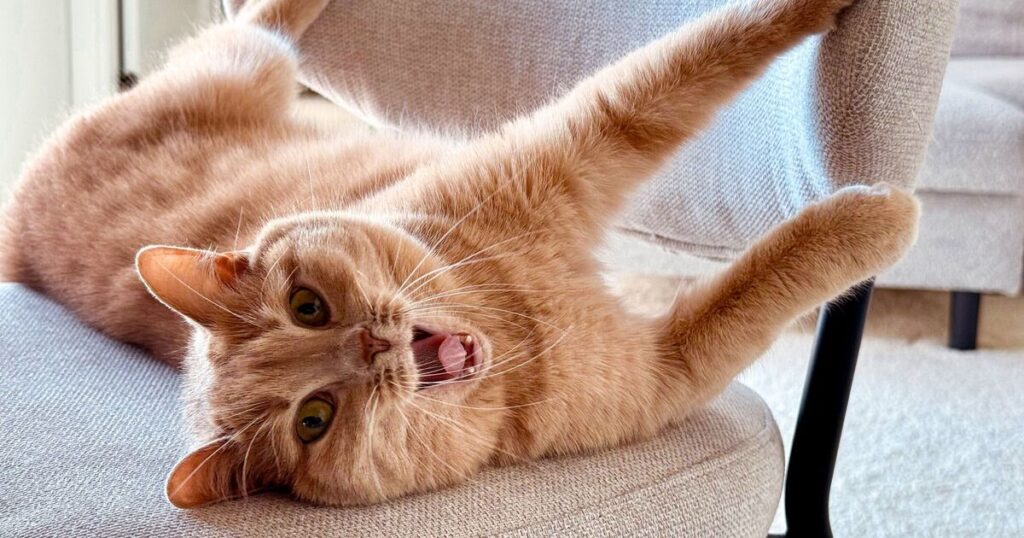
A feline expert has shared the reasons why cats misbehave and weighed in on the ‘orange cat behaviour’ idea.
It’s not uncommon for animals to show unwanted behaviours sometimes but it’s important for pet owners to understand why they behave in this way. Amanda Campion, a UK clinical animal behaviourist with more than 30 years of experience caring for cats and thousands of followers on TikTok, has discussed some of the most common issues she sees in felines, including inappropriate toileting, aggression, scratching furniture, over-grooming and vocalisation.
The expert noted that often these behaviours aren’t “bad” but they are “signals.” She said: “Cats don’t misbehave out of spite; they act out due to stress, fear, frustration, or because a need isn’t being met.”
Campion gave the example of a cat urinating outside the litter box and explained that it could be struggling with stress, pain or a territorial dispute. She added that scratching the sofa is often a “natural behaviour that hasn’t been redirected to a more appropriate surface” or could be because robust cat trees aren’t in place in the home.
The qualified animal behaviourist, who previously had her own cattery rehabilitating feral and traumatised cats, remarked: “Understanding the root cause is key, unwanted behaviours are usually a cat’s only way to express that something is wrong. It’s a cat with a problem – not a problem cat!”
One type of feline behaviour that has racked up millions of views on TikTok is ‘orange cat behaviour’. This is the idea that orange or ginger cats take part in silly antics, and are maybe more hyper or ‘chaotic’ than other cats.
Some cat owners think that if a cat is this colour then it will behave in these ways but Campion has debunked this as a myth. She explained: “Stating a behaviour that correlates to a colour is not science based and purely anecdotal, orange or tuxedo for example are just colours and not a breed.
“These colours come from a gene pool that affects pigmentation in the fur, not personality – so it is just a myth.” The feline expert added: “It’s an anecdotal perception assigned to a particular colour that other cat parents project onto their cat’s behaviour believing that their colour means their personality will follow this pattern.”
Campion shared that rather than the colour of its fur, a cat’s behaviour is shaped by a range of factors, such as genetics, early life experiences, socialisation, health, home environment, and their relationship with other pets or people in the household. Possible triggers for behaviour problems can include changes in routine, new people or animals in the home, boredom, lack of stimulation, illness, or even the layout of the home, according to her.
The feline expert shared: “Something as simple as a new scent, a loud noise, or a blocked view of the garden or a new free roaming cat in the neighbourhood, can be enough to cause behavioural changes in sensitive cats.” She said that some behaviours, like scratching, hiding or occasional hissing can be normal, but if a behaviour “becomes excessive, unpredictable, or is impacting the cat’s welfare or the harmony in the home, then it’s a red flag.”
Campion elaborated: “For example, it’s normal for cats to hide when visitors arrive, but hiding constantly or avoiding the family could indicate stress. Likewise, grooming is normal, but over-grooming to the point of hair loss suggests an issue. It’s important to look at the diet, household allergens and then search for patterns, intensity, and any sudden changes, as these are often signs that intervention is needed.”
She gave some advice for cat owners on how to deal with unwanted or challenging behaviour in their pet. Her first tip is “don’t punish the cat” and instead try to understand what the cat is communicating.
She added: “Cats only respond to positive reinforcement so reward the behaviour that you want and ignore/redirect the unwanted behaviour.” The animal behaviourist then gave some general rules to follow, including rule out medical causes and always see a vet first, provide enrichment by ensuring your cat has vertical space, scratching posts, toys, and puzzle feeders, create safe zones as “every cat needs a space where they feel safe and can retreat without disturbance” and stick to routine since cats “thrive on predictability”.
Campion recommended getting professional help from a regulated behavioural professional with a vet referral. She is a recognised and qualified behaviourist as she is a full member of the Association of Pet Behaviour Counsellors (APBC) and the Animal Behaviour and Training Council (ABTC).
The feline expert concluded by emphasising the need for seeking professional help when a cat is not behaving in a typical way: “I wish more cat parents took their cat’s red flag behaviours seriously and contacted a vet for referral to a behaviourist sooner rather than later.
“Cats never do anything by accident, every behaviour has a cause. Unwanted behaviour is usually the cat’s way of saying ‘I’m not okay.’ Early intervention makes all the difference in resolving issues and maintaining a healthy, happy cat-human relationship.”
 Latest World Breaking News Online News Portal
Latest World Breaking News Online News Portal






